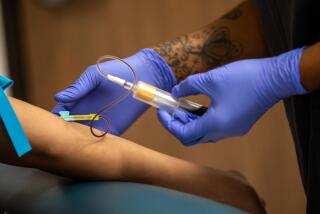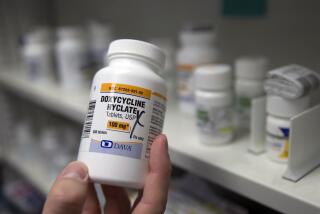Limited Funds Cited in War on Leading Sexual Disease
- Share via
WASHINGTON — Chlamydia, a serious bacterial infection that “most people can neither spell nor pronounce,” is the leading sexually transmitted disease in the country with an estimated 4.6 million new cases annually, compared to 90,000 cases of syphilis, 2 million cases of gonorrhea and 500,000 of herpes, federal health officials told Congress Monday.
But Dr. James O. Mason, director of the federal Centers for Disease Control, conceded that--although the number of cases in the United States is “staggering”--there will be no new federal funds to combat the disease because of budget restrictions.
“We’re back to the old problem of the large deficit in the national budget,” he told members of the House Energy and Commerce subcommittee on health. “This is one of our efforts to get that deficit under control.”
Chlamydia--which is pronounced kle-midea with the accent on the first syllable--can cause pelvic inflammatory disease resulting in ectopic (tubal) pregnancies or infertility in women, sterility in men and pneumonia and eye infections in infants born to infected mothers. The disease often has no symptoms in women and can go undetected for years.
Mason and others say that the disease can be treated easily with antibiotics and that it could be curtailed if the Public Health Service could establish a control program similar to the one begun in 1972 against gonorrhea. He estimated that such a program would cost $50 million to $60 million.
Demonstration Projects
Mason said, however, that the agency will spend only $4.5 million on chlamydia in fiscal 1986. Most of the money will go to five chlamydia control demonstration projects “to test various control strategies and to establish the basis for national chlamydia control recommendations,” he said.
Subcommittee Chairman Rep. Henry A. Waxman (D-Los Angeles) noted that the CDC 1986 budget for chlamydia amounted to “not even a dollar a case.”
“The budget has placed CDC and the nation’s health officers in a zero-sum game of AIDS versus gonorrhea versus syphilis versus chlamydia,” Waxman said. “In order to work on one problem, funds must be taken from another. In order for staff to deal with one disease, they must be removed from dealing with another.”
Mason said that about half of all pelvic inflammatory disease seen in the United States results from chlamydia and that the economic costs of the disease and its complications are “considerable.”
Costs of PID
“Nearly 300,000 women are hospitalized annually for PID, and women make over 2.5 million PID-related outpatient visits to health care providers each year,” he said. “The estimated cost for hospitalization and time lost from work as a result of pelvic inflammatory disease in the United States is $2.6 billion annually. Half of that amount, or $1.3 billion, can be attributed to (chlamydia) infections.”
Waxman criticized what he called the Reagan Administration’s “shortsightedness.”
“When everyone agrees that we can save billions of dollars, it’s foolish to be too cheap to spend the $50 million to control chlamydia,” he said. “That’s false thrift.”
Until a few years ago, Mason said, diagnosis of the infection was hampered by a lack of rapid, accurate and inexpensive laboratory testing procedures. “While more rapid and easy-to-perform tests are now available, their relatively high costs have as yet prohibited their widespread use as a screening tool,” he said.
More to Read
Sign up for Essential California
The most important California stories and recommendations in your inbox every morning.
You may occasionally receive promotional content from the Los Angeles Times.










